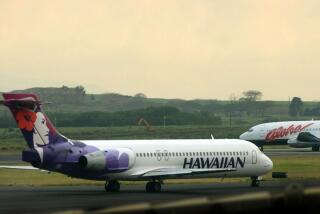State Hopes to Attract Foreign Investment : Alaska Picks Up Tab for Asians’ Junkets
- Share via
ANCHORAGE, Alaska — When eight Japanese fishing executives arrived at the Sheraton Hotel Monday, they did not have to worry about the $98 per day cost. No bill would arrive at the table after their $30 dinners. And the flowers in their rooms and other gifts costing $150 for each member of the group were all paid for with public funds from the Alaska state treasury.
In fact, the state of Alaska will pick up the $44,776 tab for the group’s six-day visit, just as the state has done for three groups of Asian businessmen who came before and just as the state will do for 11 more to follow.
This is all part of a $750,000 state-financed program to interest Asian companies in buying Alaska goods, a program that its own sponsors acknowledge is unique in the United States and is modeled along the lines of hospitality “the Oriental way.”
“I know that none of the other states have done anything like this because other states have contacted us about it,” said Merry Tuten, director of Pacific Rim Relations for Alaska Gov. Bill Sheffield. California, Nevada and Washington officials are especially interested, she said.
Sheffield himself has made three trips to Asia, with cabinet members and Alaskan businessmen, and some of the state’s expenses have been picked up by Alaska’s foreign hosts.
Is the state’s Asian-Alaska Trade Program a payback?
“You bet,” Tuten said, calling it “a pretty good expenditure of money.”
In 1984, the Alaska Legislature approved a one-line item for special projects in the governor’s budget. It read: “Pacific Rim Conference--$750,000.”
But state officials decided not to have a conference. Instead, they decided to invite trade delegations to visit Alaska, promising to pick up the total cost of the trip--from airline tickets to souvenirs.
Fisheries, timber, tourism, minerals and energy delegations were invited from China, Hong Kong, Japan, Korea, Taiwan and the Association of Southeast Asian Nations.
“From what I’ve heard we’re pretty unique,” Tuten said. “We’re doing it the Oriental way. We’re following their pattern instead of what other states are doing. When we are over there, they pay for everything.”
Tuten said: “We really lay out the red carpet. It’s not opulent, but it’s an all-out effort. It includes little gifts and flowers in the room.”
Each visit includes a reception and meal with Gov. Sheffield, costing about $60 to $70 per person. Two helicopters rented for the Korean timber delegation cost $300 per hour. The state also pays for translation services and even has a contingency fund for lost luggage. All of this is according to state documents.
Private Funds Also Used
Some of the costs are picked by private companies that hope to do business with the Asian firms. And in the case of the Korean timber delegation, federal funds from the Foreign Agricultural Service were channeled to the Alaska Loggers Assn. in a grant to pay air fare.
“All we can really do is open the door and the rest is up to private industry,” Tuten said, noting that one Asian firm that sent executives would not have come if Alaska had not paid. The company may soon be buying Alaskan resources, she said. But no deals have been signed since the first trade group came to Alaska July 28.
The program is not a junket and not a subsidy to the private sector, Tuten said, but a way of increasing Alaska’s sale of resources to its neighbors on the other side of the Pacific.
The object of the program “is to assist each major Alaskan industry in at least one area of international trade” over the next year, a project summary states.
But several trips scheduled for next year may have to be canceled: “The Bank of America bills are coming in,” Tuten said, and the program may run out of money.
More to Read
Sign up for Essential California
The most important California stories and recommendations in your inbox every morning.
You may occasionally receive promotional content from the Los Angeles Times.












